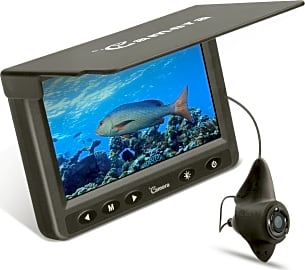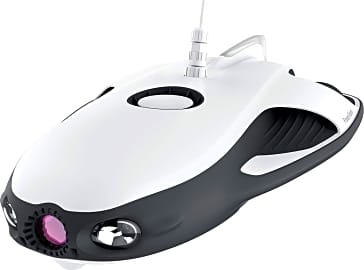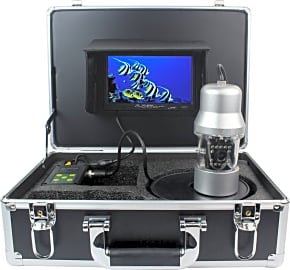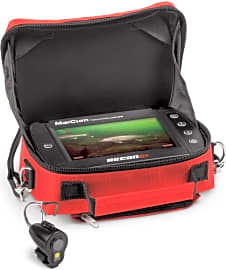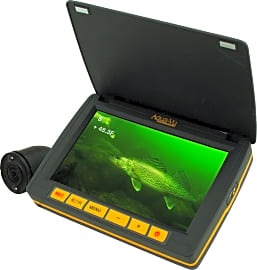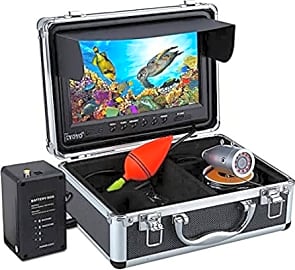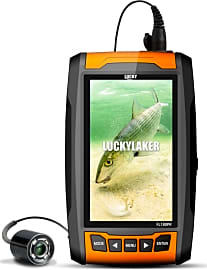The 10 Best Underwater Fishing Cameras

This wiki has been updated 35 times since it was first published in January of 2017. With such an abundance of tools and accessories available, it’s easy to go overboard when accumulating fishing gear. The underwater camera, however, is one device you probably won’t regret adding to your arsenal. Just think about it this way: What could possibly help you more than the ability to see live footage of your targets? You can even take pictures of the ones that get away. When users buy our independently chosen editorial recommendations, we may earn commissions to help fund the Wiki.
Editor's Notes
November 13, 2020:
While there weren't a lot of upgrades among the models on our list, one extremely exciting new addition is the PowerVision PRW10 Powerray Wizard, which, frankly, is likely the future for underwater fishing cameras. More than just a camera, this is effectively a drone you can control with the help of an included set of FPV goggles, creating something of a virtual reality experience that takes you beneath the waves in 4K resolution. We particularly like it because it's so immersive and interesting that it can make a day on the water a blast, even if you end up catching nothing. Of course, if comes with a fish finder, as well, so the odds of getting something to bite go up.
The other new model to join our ranking was the GoFish Cam Wireless, which stands out for being a camera that doesn't come with a monitoring device of any kind. Rather, it comes with a transmitter that floats on the surface of the water and relays video and images from the camera to a mobile device of your choosing. The app is particularly well-regarded for iOS users, but problems with its functionality on Android devices kept the selection from rising very high on our list.
We did introduce the Eyoyo 9-Inch 1000TVL as an update to the old seven-inch model. They're pretty similar in most regards other than the notable increase in display size, but the new model has a significantly longer cable than its predecessor's, which, at only 15 meters, was just long enough for most uses. Having an extra 35 meters of length can be really useful.
April 19, 2019:
We've added a couple of models to this ranking since we last visited it, including the Marcum LX-9, which boasts some serious resolution, as well the ability to toggle between black and white and color modes, which can make finding certain fish in certain waters much easier. Its price is the only thing that kept it from breaking into the top slot. Our top pick moved up from the number four position mainly on the strength of its battery, which far outlasts most of the competition.
Elsewhere, the Wosports 720p has suffered from some availability problems, but you can find similar image quality in several other options on our list, including the offerings in the top two slots.
Our former number one pick has been demoted down to number six along imaging lines as well, through there doesn't seem to be a consensus as to whether these arise from the display or the camera. It's still a smart buy given its IP67 waterproof rating, but there are definitely better models out there nowadays.
A Brief History Of Underwater Fishing Cameras
As the cost for digital components decreased, it increasingly became a bargain to shoot on digital rather than film.
The earliest ancestor of today's underwater fishing camera dates back to 1845, when English inventor Francis Ronalds discovered he could progressively record images of the instruments at an observatory by slowly pulling a photosensitive surface past an opening in his camera.
Ronalds' technique was used to record variations in scientific instruments in observatories worldwide for more than a century.
The first film camera was invented by Wordsworth Donisthorpe in 1876. The English inventor is famous for his kinesigraph, which he used to record a moving picture of the traffic in London's Trafalgar Square in 1890. All but 10 frames of Donisthorpe's original recording have been lost.
In 1887, British camera pioneer William Friese-Green was among the first to experiment with celluloid film, which would remain the standard for more than a century to follow. While advanced for its time, Friese-Green's chronophotographic camera suffered from low frame rate and unreliability.
Scottish inventor William Kennedy Laurie Dickson made another leap in camera technology in 1891, when he designed the Kinetographic Camera. Powered by an electric motor, Dickson's camera featured a much faster frame rate than its predecessors. Dickson's design laid the foundation for modern cinematography.
The first underwater camera was invented by French scientist Louis Boutan, and took 30 minutes to expose a single frame. The first underwater photo was made by Boutan in 1893. Similar to today's underwater fishing cameras, Boutan's camera featured a water-tight housing and a compressible air bladder.
The first successful hand-held film camera, called the Aeroscope, was released in 1911. Unlike other cameras, the Aeroscope did not require the operator to hand crank the film. This freed both hands for controlling focus and steadying the camera.
Prior to 1923, costly 35mm film stock was the standard for movie cameras. However, when Eastman Kodak released 16mm film stock, this lower-cost alternative sparked a new market fueled by amateur movie makers. While dismissed at release as inferior, 16mm film remained in production until the late 2000s, when digital movie cameras rose to prominence.
Digital cameras capture images digitally, recording to memory cards and hard disks, rather than film. As the cost for digital components decreased, it increasingly became a bargain to shoot on digital rather than film.
Since 2010, digital movie cameras have dominated the motion picture industry, and today digital image quality meets and even exceeds that of film in most use cases.
Today's underwater fishing cameras use digital technology to transmit images to a display in the boat. A waterproof housing protects the camera's internals, and many models feature filters and image processing to clarify underwater images.
Fishing Safety
Using an underwater fishing camera can be a great deal of fun, but it is important to avoid being distracted by the display when navigating a boat.
It is also important to wear a life jacket. Even if the boat isn't yours, you should insist that every passenger wears a life jacket.
Preparation, including charging cellular phones, and packing water, flashlights, and maps can save your life if something goes wrong.
If you frequently fish the same body of water, do not become complacent. Waterfront terrain is prone to frequent — even daily — change. When an area is declared off limits by its owner or government officials, never fish there. While you may think you know the area, it was likely restricted for your safety.
The most important fishing safety steps may take place before your boat ever touches the water. Preparation, including charging cellular phones, and packing water, flashlights, and maps can save your life if something goes wrong.
Though not an obvious fishing safety consideration, it is also important to protect yourself from the sun by wearing waterproof sunscreen of at least SPF 15, and a hat. This is true even when the sky is overcast, as harmful UV radiation can pass through cloud cover.
Humankind's Ancient Hobby
Humans have been fishing for at least 40,000 years.
Analysis of the remains of an eastern Asian man who died between 39,000 and 42,000 years ago indicates a substantial part of his diet was freshwater fish, suggesting he regularly engaged in some kind of fishing practice.
At first, fish were pulled from the water by hand, or harpooned. Then, between 4,000 and 8,000 years ago, Neolithic men developed fishing methods that are still in use today. For instance, Native Americans along the California coast deployed gorge hooks attached to line tackle.
Instead of horse hair, late-19th century fishermen preferred silk lines.
The history of recreational fishing is difficult to trace, as the lines between recreation and survival blur in ancient history.
The earliest English essay on recreational fishing dates back to 1496, not long after the printing press was invented. Titled "Treatyse of Fysshynge wyth an Angle," the essay was widely read during the 16th century, particularly by noblemen.
After the English Civil War concluded in 1651, the British turned to fly fishing as a source of recreation. In the 18th century, thanks largely to the printing press, the techniques of earlier generations and cultures were shared worldwide.
With this growing interest came commercialization, and by 1800, rods and tackle were sold in stores throughout England. In the 19th century, fly-fishing clubs were formed, and a predecessor to the modern reel reached the market.
In 1810, the first American-made bait-casting reel was developed by Kentuckian George Snyder. Favored for their strength and weight, bamboo rods imported from South American and the West Indies were frequently paired with these reels.
As the century drew to a close, tackle also improved. Instead of horse hair, late-19th century fishermen preferred silk lines.
After a lull in popularity, fishing again rose to prominence in the 1950s, with the development of affordable fiberglass rods, synthetic lines, and monofilament leaders. Baby boomers, who today have spare money and free time, have also greatly contributed to the sport's revival.


